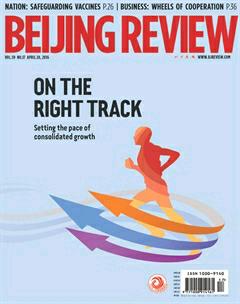Observing the Anniversary
2016-05-31本刊编辑部
Observing the Anniversary
Local residents mourn at a monument in Lushan County, southwest China’s Sichuan Province. The ceremony on April 20 was in remembrance of the 196 people who died in a devastating earthquake on the same day three years ago.

Pension Raise
Since the beginning of this year, the general level of monthly payment for pensioners from enterprises, government agencies and public institutions has been lifted by 6.5 percent from 2015, said a statement by the Ministry of Human Resources and Social Security and Ministry of Finance on April 15.
The improvement marked the 12th straight year of pension rises.
To set the level, multiple factors are considered, including economic growth, workers’ incomes and fiscal revenues, according to the statement.
Urban Settlement
China will ease household relocation policies to help more migrants settle in cities, said Xu Lin, an official with the National Development and Reform Commission (NDRC), at a press conference on April 19.
During the 13th Five-Year Plan (2016-20) period, the Chinese Government plans to raise the proportion of registered permanent urban residents to total population to 45 percent from less than 40 percent in 2015.
To achieve the goal, around 100 million migrants need to be granted with urban household registration, Xu said. He added that local authorities, especially in major cities, have been asked to loosen household relocation restrictions this year.
Meanwhile, the government will fully implement the urban residence permit system this year to help rural migrant workers enjoy equal public services in cities, Xu said.
China’s urban areas have been expanding rapidly with many migrant workers swarming into cities after decades of economic development. A top-level urban work conference held at the end of 2015 stressed that the country’s urbanization drive will focus on the integration of rural residents into urban areas.
Reading Trends
A national survey found that cellphones have become the favored way to read media in China.
About 64 percent of adults read digitally in 2015, up 5.9 percentage points, while 58.4 percent read paper books, only a 0.4-percentage-point increase, according to findings of the annual survey that were released on April 19.
The survey, conducted by the Chinese Academy of Press and Publication, polled 45,911 adults in 29 provincial-level regions. It revealed that 60 percent of respondents read on their mobile phones in 2015, up 8.2 percentage points than the previous year.
On average, readers read 3.26 ebooks, while 4.58 paper books were read per capita in 2015.
Chinese people spend more time reading on their digital devices than paper books. More than 60 minutes was spent reading on mobile phones each day in 2015, compared with 33 minutes per day in 2014.
Embryos in Space
Chinese scientists on April 17 said that they have successfully developed early-stage mouse embryos in space for the first time on a retrievable microgravity satellite, which returned to Earth on April 18.
The SJ-10 research probe, launched on April 6, carried over 6,000 mouse embryos in a selfsufficient chamber the size of a
microwave oven, according to Duan Enkui, a researcher with the Chinese Academy of Sciences.
Among them, 600 embryos were put under a high-resolution camera, which took pictures every four hours for four days and sent them back to Earth.
The pictures showed that the embryos developed from the 2-cell stage, an early-on embryonic cleavage stage, to blastocyst, the stage where noticeable cell differentiation occurs, around 72 hours after SJ-10’s launch, Duan said. The timing was largely in line with embryonic development on Earth, he added.
The rest of the embryos loaded on the satellite were injected with fixatives at 72 hours after the launch for studies on the effects of space environment on embryonic development, according to Duan.
This is the first reported successful development in mammalian embryos in space in human history.
Drug Crackdown
Police have arrested some 1.15 million suspects linked to over 1 million drug-related crimes since 2005, the National Narcotics Control Commission (NNCC) said on April 17.
Over 751 tons of drugs were seized in the period, it said.
In 2015 alone, some 38,900 suspects were arrested for trafficking illegal drugs to overseas, the NNCC said.
China reportedly had 3.23 million registered drug users as of July 2015, of which almost 60 percent were aged 35 or younger.
According to the NNCC, to counter the problem, China has signed 24 inter-governmental documents with over 20 countries in recent years to step up drug control cooperation.
It added that Chinese authorities have basically eliminated opium planting in the country by deploying remote sensing satellites to spot small opium plantations.
Driving Population
A total of 7.06 million new cars were registered in China in the first quarter this year, up 10.9 percent year on year, bringing car ownership to 179 million, according to the Ministry of Public Security on April 15.
With about 8 million new drivers added in the first quarter, China now has 289 million licensed drivers, the ministry’s Traffic Management Bureau said in a statement.
As of the end of March, motor vehicle ownership had hit 283 million, with cars accounting for more than 63 percent.
Among the 142 million registered passenger cars, more than 130 million are privately owned, the statement said.
According to the statement, there are 42 cities where car ownership has exceeded 1 million, and in 15 cities, including Beijing, Chengdu in Sichuan Province, Shenzhen in Guangdong Province, Chongqing and Shanghai, car ownership tops 2 million.
Patent Application
China continued to top the world’s patent application list for the fifth year in a row in 2015, showcasing its booming culture of innovation, an official said at a meeting on April 17.
More than 60 percent of the applications in China were filed by enterprises engaged in high-speed trains, nuclear power and 4G mobile telecommunications technology as well as ultra-high-voltage electricity transmissions, according to Wang Zhongyu, head of the China Enterprise Confederation.
However, Wang mentioned some weaknesses, such as the lack of top-level talent and key technological breakthroughs.
He called on enterprises to implement an innovation-driven development strategy to promote industrial transformation and upgrading.
Revised Rules
Defendants who stand trial while in custody will no longer have to wear prison uniforms, according to a revised protocol on court hearings made public on April 14.
The protocol, which has been in effect since 1994, has undergone a large-scale revision with 15 new articles added to better protect the rights of defendants and other participants of court hearings.
In most cases, defendants will not wear restraints, such as handcuffs or shackles, according to the document. Witnesses, expert witnesses and victims in criminal cases can testify via video link from a separated room if they need special protection. Courts have also been asked to install barrier-free facilities so that disabled citizens can attend court hearings.
Without the court’s permission, pictures or live broadcasts of hearings have been banned, and posters, banners and leaflets can no longer be brought into court. Those who disrupt court order, threaten judges, prosecutors and other parties, and destroy court property or evidence during hearings will face serious punishment.
Meanwhile, courts are required to publish information about the hearings on official websites and billboards. They can run a live or recorded broadcast of hearings of important cases on TV, the Internet and other media. Media outlets are also allowed to cover hearings.
In Memory of a Hero
Worshippers present offerings during a memorial ceremony in honor of Da Yu, a legendary hero, in Shaoxing, east China’s Zhejiang Province, on April 19.
Da Yu allegedly tamed the Yellow River and made it serve farming in the pre-historic era.

New Device
A micro-g 3D printer works in a tilting status at a research center in southwest China’s Chongqing on April 19.
The Research Center for Additive Manufacturing (3D Printing) Technology of the Chongqing Institute of Green and Intelligent Technology announced on that day that the first micro-g 3D printer has been successfully developed.

